Devonshire class Armored Cruisers (1903)
 HMS Devonshire, Antrim, Argyll, Carnarvon, Hampshire, Roxburg (1902-1922)
HMS Devonshire, Antrim, Argyll, Carnarvon, Hampshire, Roxburg (1902-1922)
The synthesis of past designs
The Devonshire class were follows-up of the previous Monmouth an attempt to improve their general characteristics while keeping dimensions and tonnage acceptable in peacetime. Nothing really changed between the armament quite close but with larger main guns, same machinery but lower speed. They all six (Devonshire, Antrim, Argyll, Carnarvon, Hampshire, Roxburg) were completed in 1905 and saw action in WWI: Argyll was wrecked, Hampshire was sunk by a naval mine and the four survivors were disposed of soon after the war.
Design of the class
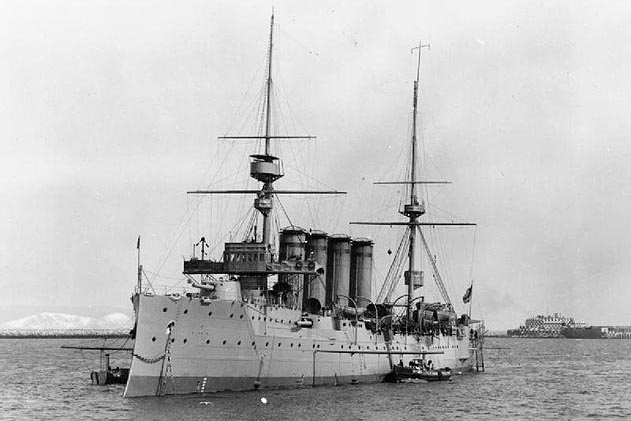
The Devonshire class followed a path of incemental improvements caracteristic of great navies of the time. They were improved versions of the preceding Monmouth class (launched 1901) with three years of design gap, and also intended for commerce protection, a vital role given the extensive network of long globe-spanning trade lines of the Empire. Their armament was made however powerful to deal with the new generation of armoured cruisers of many nations (including the Russians) and instead of the previous twin 6-inch (152 mm) turrets, they were replaced by four 7.5-inch (190 mm) single turrets, in a diamond arrangement (two broadside forward). Displacement was at the higher en of the type, at 10,850 long tons (11,020 t). The rest was constutited by casemated guns and light anti-torpedo artillery.
As usal to rapidly provide the Navy a full homogenous class without design revisions, the construction spanned six yards at the same time, all ordered in 1902, laid down from march to September to HM Dockyard, Chatham, John Brown, Clydebank, Scotts Shipbuilding & Engineering at Greenock, William Beardmore & Company in Dalmuir, Armstrong Whitworth ar Elswick and London & Glasgow Shipbuilding in Govan. Average construction cost was between £866,199 and £912,588 pounds BNA 1905. They were followed by the more powerful Duke of Edinburgh class that were leaning towards 13-15,000 tonnes and with 10 inches guns.
Hull and general design
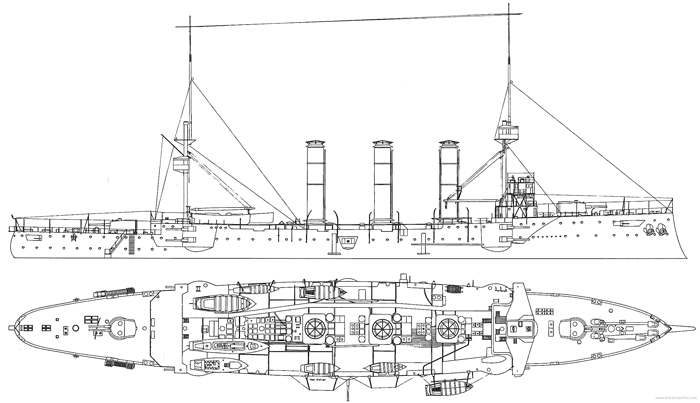
The previous Monmouth class to compare
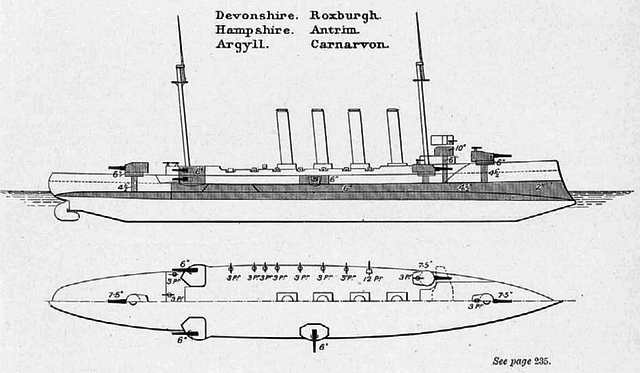
The class as depicted On Brassey’s 1905 naval annual
The Devonshire class measured overall 473 feet 6 inches (144.3 m), for a beam of 68 feet 6 inches (20.9 m) (6.8/10 ratio) and deep draught of 24 feet (7.3 m). The general appearance was quite not the same as the previous monmouth class: They had four funnels instead of three, but taking about the same space, so closer together. They looked a bit “hibrid” with their forward side turrets replacing stacked secondary casemate guns, kept aft. The forward bridge was built above the conning tower, which was tall enough to peek above the roof of the froward turret. There was the usual open bridge above. The two masts were raked, the forward one supporting a spotting top and small platform below for the forward projector. The mainmast aft supported a lower observation post and the projector platform was located at the upper level.
The ships carried twelve service boats: Six were suspended on davits along the battery deck, framing the funnels and air intakes, and the larger picket boats and steam cutters used for landing parties and laison in harbor and bteween ships were located on the deck aft, at the foot of the mainmast, served with a crane boom. The crew consisted of 610 officers and ratings.
Armour protection layout
Harvey armour for the main protection. The same scheme as the Monmounth was kept, albeit with minor differences:
-Waterline armour belt: 6 inches (152 mm).
-Weterline belt, outer (fore and aft ends): 2-inches (51mm)
-Transverse bulkheads: 5-inch (127 mm) fore and aft barbettes.
-Main gun turrets: 5 inches
-Main barbettes: 6 inches (above protective deck).
-Main armored deck armour; 0.75 inches flat section, 2 in sloped section (19–51 mm)
-Conning tower; 12 inches (305 mm) walls.
Powerplant
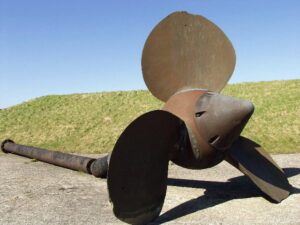
The Devonshire-class ships were powered by two 4-cylinder triple-expansion steam engines connected to a shaft each and fed by 15 to 17 and six cylindrical boilers, the whole producing a total of 21,000 indicated horsepower (16,000 kW). This enabled a top speed of 22 knots (41 km/h; 25 mph). However this changed between ships and yards: Hampshire and Antrim had 17 Yarrow, 6 cylindrical boilers, Carnarvon 17 Niclausse and same, Roxburgh 17 Durr boilers, Argyll 16 Babcock boilers and Devonshir the lead ship, 15 Niclausse boilers
For autonomy they carried 1,033 long tons (1,050 t) of coal in peacetime up to 1,950 in wartime, ensuring a 4,900 nautical miles at 13 kts range.
Armament
In short they were better armed compared to the Monmouth, with four single BL 7.5-inch, sinx single BL 6-inch, two single 12-podr, eighteen QF 3-pounder (47 mm) Hotchkiss and the usual torpedo tubes.
Main
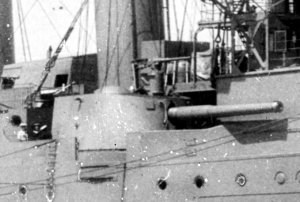 The main armament consisted in four breech-loading (BL) 7.5-inch Mk I guns in single-gun turrets. This optimised forward firing and chase firing unlike a twin-turret solution, since all three guns could be brough to bear at any angle, chase in retreat. Designed circa 1901 by Vickers and introduced from 1905, only 33 were built, for the Devonshire class. They weighted 13.7 long tons (13.9 t) for a barrel length o 28 feet (8.534 m) (bore 45 calibres), then firing a 200 pounds (90.7 kg) shell. They used the classic Welin breech block and could elevate -5° to +15°, for a ROF of 4-5 rpm
The main armament consisted in four breech-loading (BL) 7.5-inch Mk I guns in single-gun turrets. This optimised forward firing and chase firing unlike a twin-turret solution, since all three guns could be brough to bear at any angle, chase in retreat. Designed circa 1901 by Vickers and introduced from 1905, only 33 were built, for the Devonshire class. They weighted 13.7 long tons (13.9 t) for a barrel length o 28 feet (8.534 m) (bore 45 calibres), then firing a 200 pounds (90.7 kg) shell. They used the classic Welin breech block and could elevate -5° to +15°, for a ROF of 4-5 rpm
and 2,700 ft/s (820 m/s) muzzle velocity. This elevation have them a range of only 7.9 mi (12.7 km). However after latr modifications it was alleged ported to 13,800 yards (12,600 m) in WW1.
Secondary
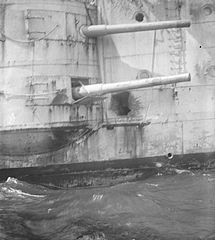 Their secondary armament comprised six BL 6-inch Mk VII guns, all arranged in casemates amidships. Four mounted on the main deck level, usable by calm weather, the aft one on a two-storey casemate.
Their secondary armament comprised six BL 6-inch Mk VII guns, all arranged in casemates amidships. Four mounted on the main deck level, usable by calm weather, the aft one on a two-storey casemate.
Designed by Vickers these fairly common models started in 1899 and arrived in the navy in 1901, with 898 produced (some saw field use). They weighted 16,875 lb (7,654 kg) for 25 tons and needed nine operators. They used a Welin interrupted screw for 8 rpm, firing a Lyddite, HE, Shrapnel 100 lb (45 kg) at between 2,525 ft/s and 2,775 ft/s (846 m/s) and up to 12,200 yards (11,200 m).
Anti-TB armament
The ships also carried 18 quick-firing (QF) 3-pounder Hotchkiss guns along the battery deck, with masks, and two 12-pounder 8-cwt guns (76mm/40 12pdr 12cwt QF Mk I) on the wings, that could be dismounted for landing parties ashore.
Torpedo Tubes
They also carried two single 18-inch (45 cm) torpedo tubes (submerged). One reload each. Whitehead 1900 model.
Design Modifications
During their WWI overhauls, their lower main deck 6-in guns were moved to the upper deck, with gun shields. The four casemates were plated over, improving seakeeping. Also four 3-pdr guns which were located there were landed. They carried their grey livery all along their WW1 service as camouflage was rare on this class, there is no photo to show it, even in 1918 and despite their escort missions against submersibles.
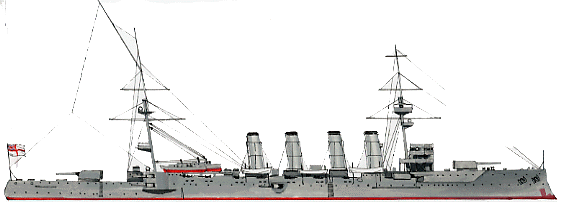
Author’s profile of the Devonshire class in 1914.
⚙ Devonshire specifications |
|
| Dimensions | 144,32 x 20,9 x 7,3 m |
| Displacement | 9 600 t, 10 850 T FL |
| Crew | 665 |
| Propulsion | 2 shafts 4-cyl. TE, 21 boilers, 21 000 hp. |
| Speed | 22 knots (41 km/h) |
| Range | 6,680 nautical miles (12,370 km) at 10 knots (19 km/h) |
| Armament | 4 x 190 (4×1), 6 x 152, 2 x 76, 18 x 47, 2 x 457mm TTs (sub). |
| Armor | Belt 152, Battery 105, Barbettes 152, turrets 76, CT 305, decks 60 mm. |
General assessment
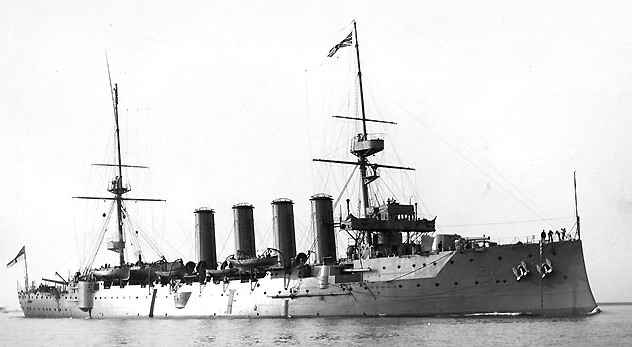
Devonshire in 1904. These cruisers stayed with the Grand Fleet in Atlantic escort missions and northern patrols, seeing little to no combat.
After completion, these ships were based in territorial waters within the Home Fleet, except for HMS Carnarvon, which was posted to Gibraltar for 2 years, and Hampshire, which did the same in 1911 and then moved to Hong Kong in 1912.
HMS Antrim captured a German freighter as early as August 6, 1914, then in the Grand Fleet. She narrowly escaped October 9 the attack of an unidentified U-Boote. Based in Arkhengeslk from June 1916, she was later based in South America and the Indian Ocean. In Dec. 1917 she was back home, reserve and back in service in August-September 1918. She became postwar an experimental ship for the Asdic then cadets TS cadets until 1922.
HMS Argyll captured a German freighter on 6 August 1914 but ran aground at Bell Rock reef on 28 October 1915, a constructive loss. HMS Carnarvon captured a German freighter. She patrolled from Cape Verde in August 1914 was in Montevideo by October, leading a squadron and taking part in the the battle of the Falklands in December, suffering extensive damage on the Abrolhos reefs. Repaired in Rio she was assigned the North America station, and Indian Ocean NS until 1918. HMS Devonshire captured a German freighter in the Atlantic Ocean too in August 1914. She spent her time between Scapa Flow and Norway and from December 1916 in the East Indies until V-Day.
HMS Hampshire also captured a German freighter then took part in the search for Admiral Graf Spee and Emden squadrons. Back in the Grand Fleet she started escorting convoys to the White Sea but took part in the Battle of Jutland with the 2nd cruiser squadron. She carried Lord Kitchener to Russia but hit a mine and sank off the Shetlands in June 1916.
HMS Roxburg was torpedoed on June 20, 1915, but saved by her crews. Towed and repaired, from April 1916 she was based in Norway, then East Indies/North America Station until the armistice. During this service she managed to ram and sink U89.
These records shows rare ship-to-ship encounters, but a varied escort service on all seas. They fell to mines and U-Boat torpedoes typical of WW1, plus the usual uncharted rock “surprise” when not a collision. Their anti-shipping campaign in 1914 was successful. But on the grand scheme of things, their combat service history was rather unglamorous as only one, Hampshire, took part in a significant naval battle and had the occasion to fight. Apart their usual ASW protection weakness caracteristic of the time, the fact that one could be saved denoted that still possible, given the place hit, officer’s reaction and crew’s skills. But design-wise they suffered no particular issue, being considered good sea boats (their useless lower deck guns were replaced one deck above), having a good compromise for artillery that was repeated on the next classes of British armoured cruisers.
Read More
Books
Brassey, T.A. (ed)The Naval Annual 1905
Chesneau, Roger & Kolesnik, Eugene M., Conway’s All the World’s Fighting Ships 1860–1905.
Corbett, Julian. Naval Operations to the Battle of the Falklands. Vol. I, London and Nashville IWM & Battery Press6-X.
Friedman, Norman (2012). British Cruisers of the Victorian Era. Barnsley, South Yorkshire, UK: Seaforth.
Friedman, Norman (2011). Naval Weapons of World War One. Barnsley, South Yorkshire, UK: Seaforth.
Leyland, J. and Brassey, T.A. (ed) Brassey’s Naval Annual|The Naval Annual 1906
Massie, Robert K. (2004). Castles of Steel: Britain, Germany, and the Winning of the Great War at Sea. Jonathan Cape.
Silverstone, Paul H. (1984). Directory of the World’s Capital Ships. New York: Hippocrene Books.
Links
http://dreadnoughtproject.org/tfs/index.php/Devonshire_Class_Cruiser_(1903)
The Devonshire class on wikipedia
http://www.historyofwar.org/Pictures/pictures_plan_devonshire_class_cruiser.html
http://www.historyofwar.org/articles/weapons_devonshire_class_cruisers.html
https://www.battleships-cruisers.co.uk/devonshire_class.htm
https://www.navypedia.org/ships/uk/brit_cr_devonshire.htm
Model Kits
None known. Feel free to add one kit on the comments below.
First Published in June 2018
 HMS Devonshire
HMS Devonshire

Devonshire was ordered to HM Dockyard, Chatham, laid down 25 Mar 1902, launched 30 Apr 1904 and completed on 24 Aug 1905 at a coast in 1905 of £900,792. She was at first assigned to the 1st Cruiser Squadron, Channel Fleet. Transferred to the 2nd Cruiser Squadron, Atlantic Fleet (March 1907), by August 1909 she was reassigned to reserve Third Fleet based in Devonport. By 1913 she was fully reactivated and assigned to the 3rd Cruiser Squadron, Second Fleet together consisting of most of her sister ships.
As war grew near, she was reaffected to the Grand Fleet by mid-1914 and fully mobilized, but from August she spent her time in patrols near the Shetland and Faeroe Islands, and eastwards to the Norwegian coast, whereas Devonshire captured a German merchantman (on 6 August). Refitted in September and February that year she resume the same routine without incident. Patrolling the Norwegian coast however from April 1916 she was reassigned to the Nore and later to the 7th Cruiser Squadron, Grand Fleet, then transferred to the Atlantic, protecting Allied shipping by December 1916. This was the North America and West Indies Station, escorting further ships trans-atlantic. She went on until decommissioned in 1919, and stricken, on disposal in May 1920, then sold on 9 May 1921, BU at Barrow-in-Furness, 1923. Her name was assigned to a County class cruiser, just ordered.
 HMS Antrim
HMS Antrim
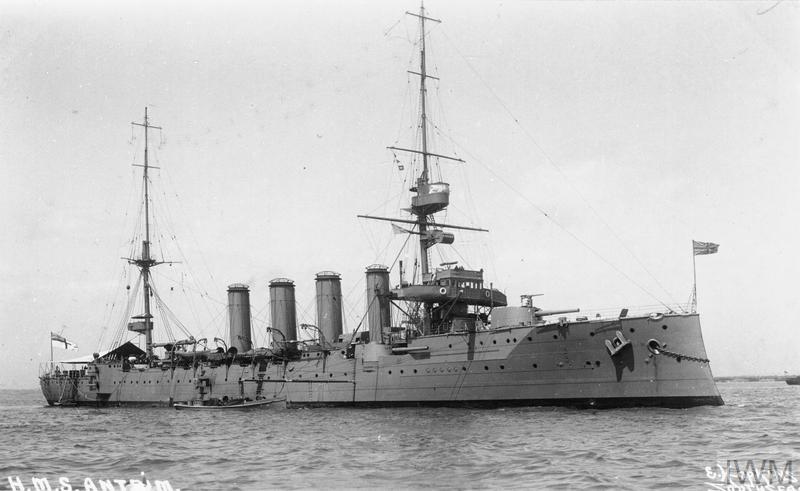
HMS Antrim was built at John Brown, Clydebank, laod down on 27 Aug 1902, launched 8 Oct 1903 and completed on 23 Jun 1905 at a cost of £899,050 all included. She was assigned to the 1st Cruiser Squadron, Channel Fleet together her sisters. Then she was sent in Casablanca, Morocco by August 1907 to assist a coalition againsy an insurrection thteatening westerner citizens. This led ultimately to the bombardment of Casablanca. Transferred to the 2nd Cruiser Squadron, Atlantic Fleet in March she later joined in April the reserve Third Fleet, Devonport. In 1911 she was sent to the Mersey fo show her guns during the 1911 Liverpool general transport strike. In December 1912, she became flagship of the 3rd Cruiser Squadron, second Fleet.
By mid-1914 she joined the grand fleet at Scapa flow, reinforcing patrols near the Shetland and Faeroe and eastwards to the Norwegian coast. At this occasion she captured a German merchantman on 6 August. In October she saw the trays of torpedo waves close to her, launched from U-16 on 9 October. She multiplied sorties with the Grand Fleet but failed to see active combat. In the end she ws sent to Archangelsk, white sea, to assist convoy escorts from June 1916 before transferred to the North America and West Indies Station, far warmer waters. HMS Antrim was back to the home fleet by December 1917, paid off to free crews, but recommissioned in August 1918 for the same escort missiones until the capitulation. Place in reserve at the Nore in 1919 she carried out Asdic trials in March 1920 and became cadet TS in 1922, then sold for BU on 19 December 1922 at Blyth, Northumberland.
 HMS Argyll
HMS Argyll
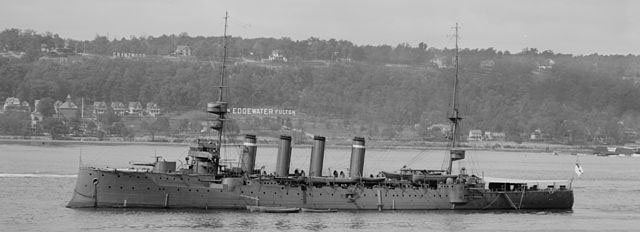
HMS Argyll was laid down at Scotts Shipbuilding & Engineering (Greenock, Scotland) on 1st Sep 1902, launched 3 Mar 1904 and completed on December 1905 (construction cost £912,588). Name after a Scottish county, she was assigned to the 1st Cruiser Squadron, Channel Fleet, in January 1906. Transferred to the 5th Cruiser Squadron, Atlantic Fleet in 1909, in 1910 she escorted the Royal Yacht Medina during the King’s Delhi 1911–12 cruise. When back to Plymouth she ran aground on 28 December. After repairs in 1913 she was attacjed to the 3rd Cruiser Squadron, Second Fleet.
By mid-1914 she joined the Grand Fleet and stayed in patrols in the Shetland-Faeroe area, and Norwegian coast, allowing her to capture a German merchantman, on 6 August. She ran aground again, this time on the Bell Rock, near Dundee on 28 October 1915. Thus happened during a storm since lighthouses were switch shut off for fear of assisting U-boats. She sent a signal requesting the light to be turned on on a special permission, but the lighthouse had no radio to receive it, not could see the ship’s lights visuals. Unable to modify the lighthouse she proceeded, still expecting using the light at some point, until ran aground at 04:30 (on charted but unseen reefs). The damage was massive and a fire started in her machinery, the crews fought for hours. By radio a SOS sscrambled all ships available and soon, two destroyers, HMS Hornet and Jackal on site, evacuating the entire crew. The salvaged followed when the weather allowed it the new days, for all valuable items on board and this included guns and ammunitions, then she was broken up by the salvage team. Her propellers were recovered only in 1970. The rest of the wreck is still there, a popular diver’s spot.
 HMS Carnarvon
HMS Carnarvon
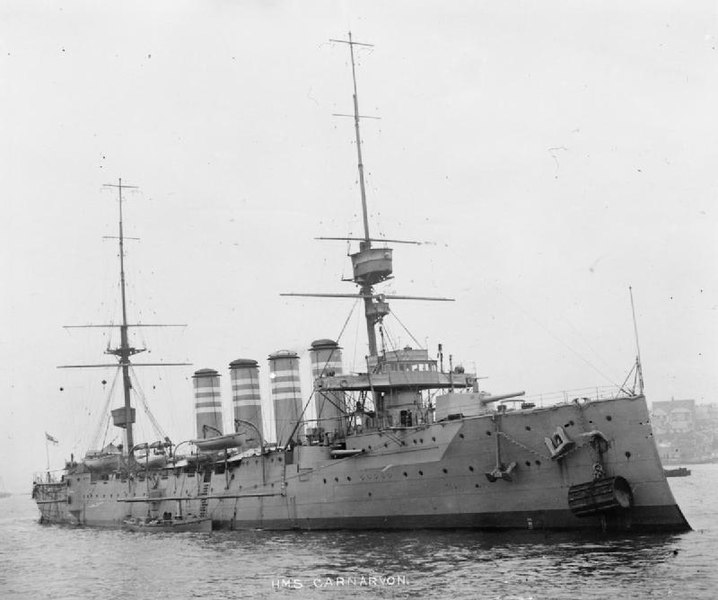
HMS Carnarvon was ordered and laid down to William Beardmore & Company, Dalmuir on 1 Oct 1902, launched 17 Oct 1903 and completed on 29 May 1905 (cost £899,465), Carnarvon, named after the Welsh county. She was assigned to the 3rd Cruiser Squadron, Mediterranean Fleet but retransferred to the 2nd Cruiser Squadron, Atlantic Fleet in June 1907, and next, reserve, Third Fleet at Devonport by April 1909. Next she joined the Second Fleet still there in March 1912 and flagship of the 5th Cruiser Squadron until the war. She took part in both the July–August 1913 and July 1914 fleet manoeuvers.
On 5 August she was now flagship of Rear Admiral Archibald Stoddart, heading to the Canary Islands from Gibraltar, then Cape Verde. There, she intercept the German merchant ship SS Professor Woermann, on 23 August 1914. The prize ship was escorted to Freetown, Sierra Leone for disposal. Next she patrolled along the Brazilian coast by October 1914 and arrived in the Falkland Islands, joining Vice-Admiral Doveton Sturdee’s squadron. Hence her participation to the battle. (See the article: Battle of the Falklands)
After she arrived at Port Stanley on 7 December, Sturdee wanted to have all ships recoaling from the two available colliers and then start searching for Von Spee’s East Asia Squadron, believed rounding the cape at that time. Meanwhile von Spee planned to destroy Port Stanley’s radio station on 8 December. Sturdee first spotted them at 07:30, caught off-guard, and scrambled the ships. At first HMS Canopus main guns drive them out, and Carnarvon completed her recoaling at 08:00 so the entire sqaudron was made ready to leave at 10:30 with “general chase” ordered. Carnarvon could only achieve 18 knots and fell behind and the pack was led bt the two battlecruisers followed by the cruisers, opening fire at 12:55.
SMS Leipzig was straddled first. Von Spee’s own armoured crusiers were slower and soon her order his fleet to scatter, covering their retreat by boldly engaging Sturdee with Scharnhorst and Gneisenau. The three light cruisers started their made escape at 13:20 and Carnarvon which closed op to 10 nautical miles (19 km; 12 mi) was only able to trail the battlecruisers as theu engaged Von Spee. When she eventually came within range, she opened fire on them but alread Scharnhorst capsized at 16:17. She turned to Gneisenau until the “cease fire” ordered at 17:50. The latter’s captain was asked to scuttle his ship and it was done at 18:00. Carnarvon rescued 20 survivors and then turned to the sinking spot of the other, but failed to pick up more.
Next, the hunt for SMS Dresden started in anchorages in Argentina, Chile and South Georgia. Failing to find her, Carnarvon sailed to Brazil in February but struck a coral reef off the Abrolhos Archipelago (22 February 1915), beached to avoid sinking. By that point she was probably the most unlucky cruiser in her class and perhaps of all British cruisers. After temporary repairs at Rio de Janeiro in March, she received permanent ones in Montreal, Canada (May-July). She departed to escort Canadian-built H-class submarines from Halifax to Devonport. Back to Halifax she stayed there to escort other east-bound convoys.
Later she was assigned to tje North America and West Indies Station, home port Royal Naval Dockyard, Bermuda’s Imperial fortress, and she went on escorting more convoys until V-Day. She also assisted the grounded USS Stewart at Bermuda on 16 August 1917. In 1919, she became a cadet TS until decommissioned, stricken on March 1921 and sold for BU in November 1921, in Germany.
 HMS Hampshire
HMS Hampshire
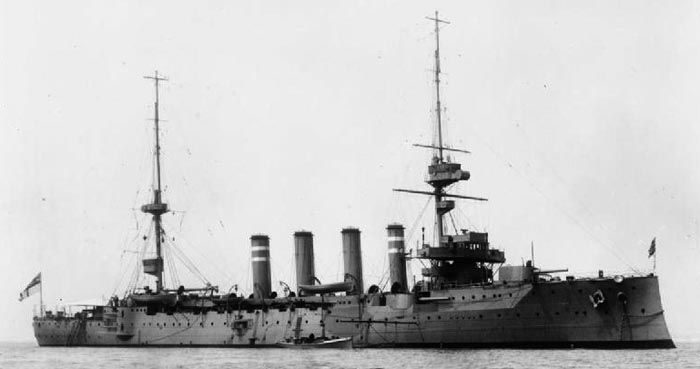
HMS Hampshire was ordered to Armstrong Whitworth, Elswick, started on 1 Sep 1902, launched 24 Sep 1903 and completed on 15 Jul 1905 at a cost of £872,327. She at first served wit the 1st Cruiser Squadron, Channel Fleet, was refitted at Portsmouth Royal Dockyard in December 1908 and reassigned to the reserve Third Fleet by August 1909. Fully recommissioned in December 1911 she was assigned to the 6th Cruiser Squadron, Mediterranean Fleet and then China Station in 1912.
In August 1914 she was stationed in Wei Hai Wei, reassigned to Vice Admiral Martyn Jerram’s squadron. Her first mission was to deal with the German radio station at Yap with Minotaur and Newcastle. En route they captured the German collier SS Elspeth on 11 August. HMS Hampshire was soon running out of coal and ordered head back to Hong Kong with the crew of the Elspeth. Next, she proceeded to the Dutch East Indies, again looking for German ships. SMS Emden passed nearby but she was too far away to spot her. She was soon in chase in October-November, assisted by the armed merchant cruiser Empress of Asia, but Emden was eventually sunk on 9 November by HMAS Sydney.
She escorted an ANZAC troop convoy through in the Indian Ocean and Red Sea, then Egypt and crossed the Mediterranean to be refitted and overhauled at Gibraltar in December. She was then sent back to the Grand Fleet, 7th Cruiser Squadron, by January 1915. In November she escorted convoys to the White Sea and was back in time to take part in the Battle of Jutland on 31 May 1916 as part of the 2nd Cruiser Squadron. She was never engaged and only fired four salvos on the II Scouting Group making no hits.
Next she carried Lord Kitchener from Scapa Flow to Russia, Arkhangelsk. Gale-force winds forced her to sail through the Pentland Firth and turn north west of the Orkney Islands. At 17:45 she met her escorts, HMS Unity and Victor adn the gale forced them to face it head on, caused both destroyers to fall behind until HMS Hampshire’s Captain Savill ordered both back. While 1.5 mi (2.4 km) off Orkney’s Brough of Birsay, Marwick Head at 19:40, 5 June 1916 and explosion was heeard, and she took a list rapidly to starboard. It appeared she struck mines laid by the German minelaying submarine U-75 in later May before the battle, part of Scheer’s plans. Not only she had flooding from several holes but her lifeboats were smashed during the gale and in 15 minutes she sank by the bow with only 12 survivors, 737 lost, including lord Kitchener the whole mission to Russia’s staff. Her wreck is now protected, but the propellers were salvaged and are now in display.
 HMS Roxburgh
HMS Roxburgh
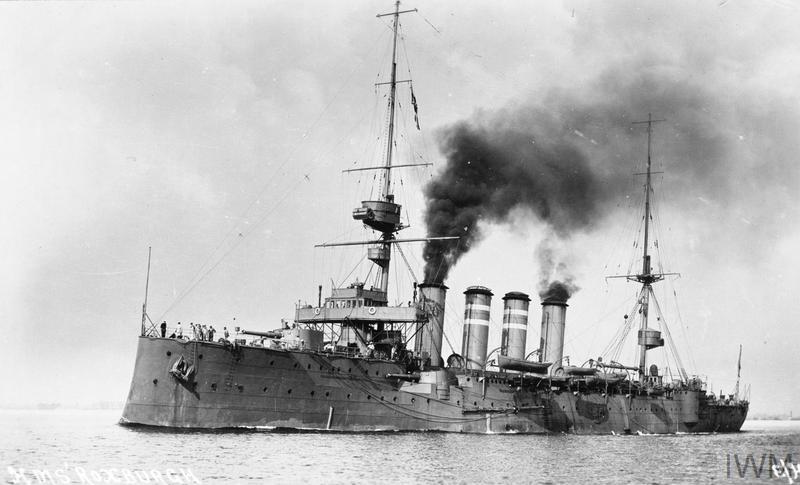
HMS Rosburg (after a Scottish County) was laid down at London & Glasgow Shipbuilding in Govan on 13 Jun 1902. She was launched on 9 Jan 1904 and completed 5 Sep 1905 at a cost of £866,199. Construction was slowed due to a late boilers delivery. At first sher was assigned to the 1st Cruiser Squadron, Channel Fleet before a refit at Devonport Royal Dockyard, by December 1908. She joined the reserve Third Fleet until June 1912, then the 3rd Cruiser Squadron, Second Fleet. She assisted the stranded merchantman SS Ludgate off Morocco.
When the war broke out she was with the Grand Fleet by mid-1914, speinf much time in patrols in the Shetland-Faeroe and Norway, captured a German merchantman on 6 August (same as her sisters). On 18 June 1915, she sailed to Rosyth with the 3rd Cruiser Squadron, 2nd Light Cruiser Squadron for a large North Sea foray. They spotted several U-Boats, HMS Roxburgh being hit by a torpedo in her bow (launched by SM U-38) on 20 June. He damage control teams did wonders and stopped the flooding and since she still has her machinery intact, she managed to return to Rosyth, but remained in repairs until April 1916.
At that time she returned to the Norwegian coast before joining the North America and West Indies Station in September like may of her sisters, for escort. On 13 February 1918 Roxburgh rammed and sank U-89, north of Malin Head (Ireland). She was placed in reserve, Plymouth by June 1919, recommissioned for testing radio equipments and train radoo specialists until paid off in February 1920, sold on 8 November 1921.

 Latest Facebook Entry -
Latest Facebook Entry -  X(Tweeter) Naval Encyclopedia's deck archive
X(Tweeter) Naval Encyclopedia's deck archive Instagram (@navalencyc)
Instagram (@navalencyc)





 French Navy
French Navy Royal Navy
Royal Navy Russian Navy
Russian Navy Armada Espanola
Armada Espanola Austrian Navy
Austrian Navy K.u.K. Kriegsmarine
K.u.K. Kriegsmarine Dansk Marine
Dansk Marine Nautiko Hellenon
Nautiko Hellenon Koninklije Marine 1870
Koninklije Marine 1870 Marinha do Brasil
Marinha do Brasil Osmanlı Donanması
Osmanlı Donanması Marina Do Peru
Marina Do Peru Marinha do Portugal
Marinha do Portugal Regia Marina 1870
Regia Marina 1870 Nihhon Kaigun 1870
Nihhon Kaigun 1870 Preußische Marine 1870
Preußische Marine 1870 Russkiy Flot 1870
Russkiy Flot 1870 Svenska marinen
Svenska marinen Søværnet
Søværnet Union Navy
Union Navy Confederate Navy
Confederate Navy Armada de Argentina
Armada de Argentina Imperial Chinese Navy
Imperial Chinese Navy Marinha do Portugal
Marinha do Portugal Mexico
Mexico Kaiserliche Marine
Kaiserliche Marine 1898 US Navy
1898 US Navy Sovietskiy Flot
Sovietskiy Flot Royal Canadian Navy
Royal Canadian Navy Royal Australian Navy
Royal Australian Navy RNZN Fleet
RNZN Fleet Chinese Navy 1937
Chinese Navy 1937 Kriegsmarine
Kriegsmarine Chilean Navy
Chilean Navy Danish Navy
Danish Navy Finnish Navy
Finnish Navy Hellenic Navy
Hellenic Navy Polish Navy
Polish Navy Romanian Navy
Romanian Navy Turkish Navy
Turkish Navy Royal Yugoslav Navy
Royal Yugoslav Navy Royal Thai Navy
Royal Thai Navy Minor Navies
Minor Navies Albania
Albania Austria
Austria Belgium
Belgium Columbia
Columbia Costa Rica
Costa Rica Cuba
Cuba Czechoslovakia
Czechoslovakia Dominican Republic
Dominican Republic Haiti
Haiti Hungary
Hungary Honduras
Honduras Estonia
Estonia Iceland
Iceland Eire
Eire Equador
Equador Iran
Iran Iraq
Iraq Latvia
Latvia Liberia
Liberia Lithuania
Lithuania Mandchukuo
Mandchukuo Morocco
Morocco Nicaragua
Nicaragua Persia
Persia San Salvador
San Salvador Sarawak
Sarawak Uruguay
Uruguay Venezuela
Venezuela Zanzibar
Zanzibar Warsaw Pact Navies
Warsaw Pact Navies Bulgaria
Bulgaria Hungary
Hungary

 Bundesmarine
Bundesmarine Dutch Navy
Dutch Navy Hellenic Navy
Hellenic Navy Marina Militare
Marina Militare Yugoslav Navy
Yugoslav Navy Chinese Navy
Chinese Navy Indian Navy
Indian Navy Indonesian Navy
Indonesian Navy JMSDF
JMSDF North Korean Navy
North Korean Navy Pakistani Navy
Pakistani Navy Philippines Navy
Philippines Navy ROKN
ROKN Rep. of Singapore Navy
Rep. of Singapore Navy Taiwanese Navy
Taiwanese Navy IDF Navy
IDF Navy Saudi Navy
Saudi Navy Royal New Zealand Navy
Royal New Zealand Navy Egyptian Navy
Egyptian Navy South African Navy
South African Navy






























 Ukrainian Navy
Ukrainian Navy dbodesign
dbodesign